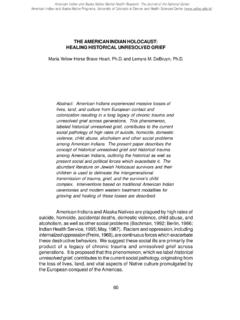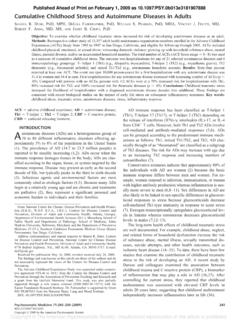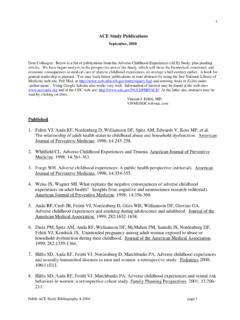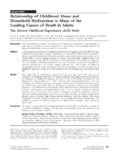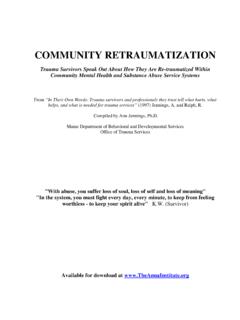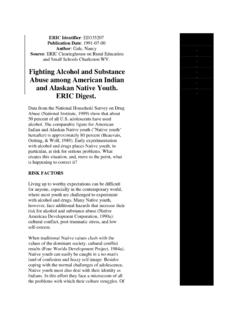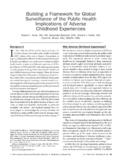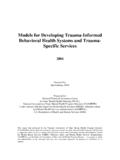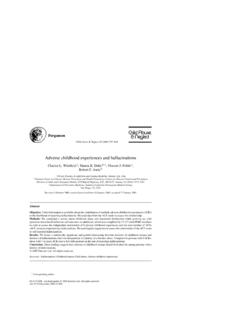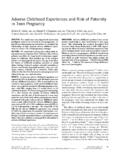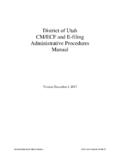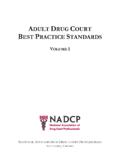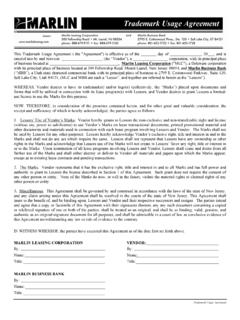Transcription of “FREQUENTLY ASKED QUESTIONS ABOUT PUBLIC …
1 frequently ASKED QUESTIONS ABOUT PUBLIC LAW 280 . 1. How did PUBLIC Law 280 change the rules of jurisdiction for reservations and other Indian Country? Before PUBLIC Law 280 was enacted, the federal government and the tribal courts shared jurisdiction, exclusive of the states , over almost all civil and criminal matters involving Indians on the reservations. With the enactment of PUBLIC Law 280, affected states received criminal jurisdiction over reservation Indians, In addition, PUBLIC Law 280 opened state courts to civil litigation that previously had been possible only in tribal or federal courts.
2 In the six states actually named in PUBLIC Law 280, the federal government gave up all of its special criminal jurisdiction over crimes involving Indian perpetrators or victims. 2. Did PUBLIC Law 280 change the trust status of Indian land or exclude Indians in affected states from receiving benefits under federal Indian programs? PUBLIC Law 280 did not affect the trust status of Indian lands. Neither did it exclude Indians in affected states from receiving benefits under federal Indian programs, such as the Indian Health Service or Indian education grants.
3 However, the Bureau of Indian Affairs has sometimes used PUBLIC Law 280 as an excuse for reducing or eliminating funding for federal Indian programs in affected states . For example, when California came under PUBLIC Law 280, the Bureau eliminated funding for certain education programs. This response by the Bureau cannot be justified by the language of PUBLIC Law 280, and the Bureau has begun restoring the benefits that were withdrawn after enactment of PUBLIC Law 280. 3. Which states are affected by PUBLIC Law 28-? The mandatory states , required by PUBLIC Law 280 to assume jurisdiction, are Alaska, California, Minnesota (except Red Lake), Nebraska, Oregon (except Warm Springs), and Wisconsin.
4 The optional states , which elected to assume full or partial state jurisdiction, are Arizona (1967), Florida (1961), Idaho (1963), subject to tribal consent), Iowa (1967), Montana (1963), Nevada (1955), North Dakota (1963, subject to tribal consent), South Dakota (1957-61(, Utah (1971), and Washington (1957-63). 4. Did tribes have to give their consent before PUBLIC Law 280 could take effect? For the six states named in PUBLIC Law 280, state jurisdiction was put into effect without securing prior consent of the affected tribes.)
5 Some of the optional states voluntarily chose to assume jurisdiction only over tribes that consented. In 1968 PUBLIC Law 280 was amended to require consent for any future state jurisdiction under PUBLIC Law 280. however, tribes could not undo state jurisdiction established between 1953 and 1968. 5. What is retrocession? How can retrocession be initiated under PUBLIC Law 280? Initially, PUBLIC Law 280 did not contain a provision permitting the states and the tribes to demand the return or retrocession of state PUBLIC Law 28- jurisdiction to the federal government.
6 However, in order to relieve the states ' financial difficulties with PUBLIC Law 280, the 1968 civil Rights Act enabled the states that had assumed PUBLIC law 280 to offer the return of all or any measure of their jurisdiction to the federal government. The federal government would have the final say on whether to accept the retrocession. Not only were the Indians given no veto power over state-initiated retrocession; they had no way of imposing retrocession on an unwilling state that had acquired jurisdiction. 6. Are there any limits to state authority under PUBLIC Law 280?
7 states may not apply laws related to such matters as environmental control, land use, gambling, and licenses if those laws are part of a general state regulatory scheme. PUBLIC Law 280 gave states only law enforcement and civil judicial authority, not regulatory matters, particularly property held in trust by the United states and federally guaranteed hunting, trapping, and fishing rights. The state cannot tax on the reservations. The United states Supreme Court has interpreted PUBLIC law 280 as a statute designed to open state courts to civil and criminal actions involving reservation Indians, not to subject reservations to the full range of state regulation.
8 Finally, there are some matters so central to the very definition of the tribe, such as enrollment and certain domestic relations matters, that even state courts may be excluded from hearing such matters. 7. Are municipal and county laws applicable under PUBLIC Law 280? PUBLIC Law 280 may have rendered only statewide law applicable to reservation Indians, excluding municipal and county laws. There are some judicial decisions that reject the application of local law to Indian reservations under 280. The rationale that courts have used to justify excluding local laws is that PUBLIC Law 280 was not intended to deny tribes their basic governmental functions.
9 8. Have any federal laws enacted after PUBLIC Law 280 reduced state authority on reservations? Certain federal statutes enacted after PUBLIC Law 280 have reduced the amount of jurisdiction available to states under the 1953 law, simultaneously increasing tribal sovereignty or federal power. In 1978, Congress enacted the Indian Child Welfare Act, which gives tribes exclusive jurisdiction over certain child custody proceedings involving Indian children. The act also regulates some other aspects of child custody. The Indian Gaming Regulatory Act of 1988 is another federal statute that supersedes or preempts 280.
10 It makes enforcement of state gambling laws a federal rather than a state responsibility. 9. Can tribes have their own courts and systems of law in PUBLIC Law 280 states ? Indian tribes have inherent sovereign authority. Most courts and attorneys general have found that under PUBLIC Law 280, the tribes have retained civil jurisdiction over activities within Indian country as well as criminal jurisdiction over Indians. A few states , such as California, dissent from this view.
